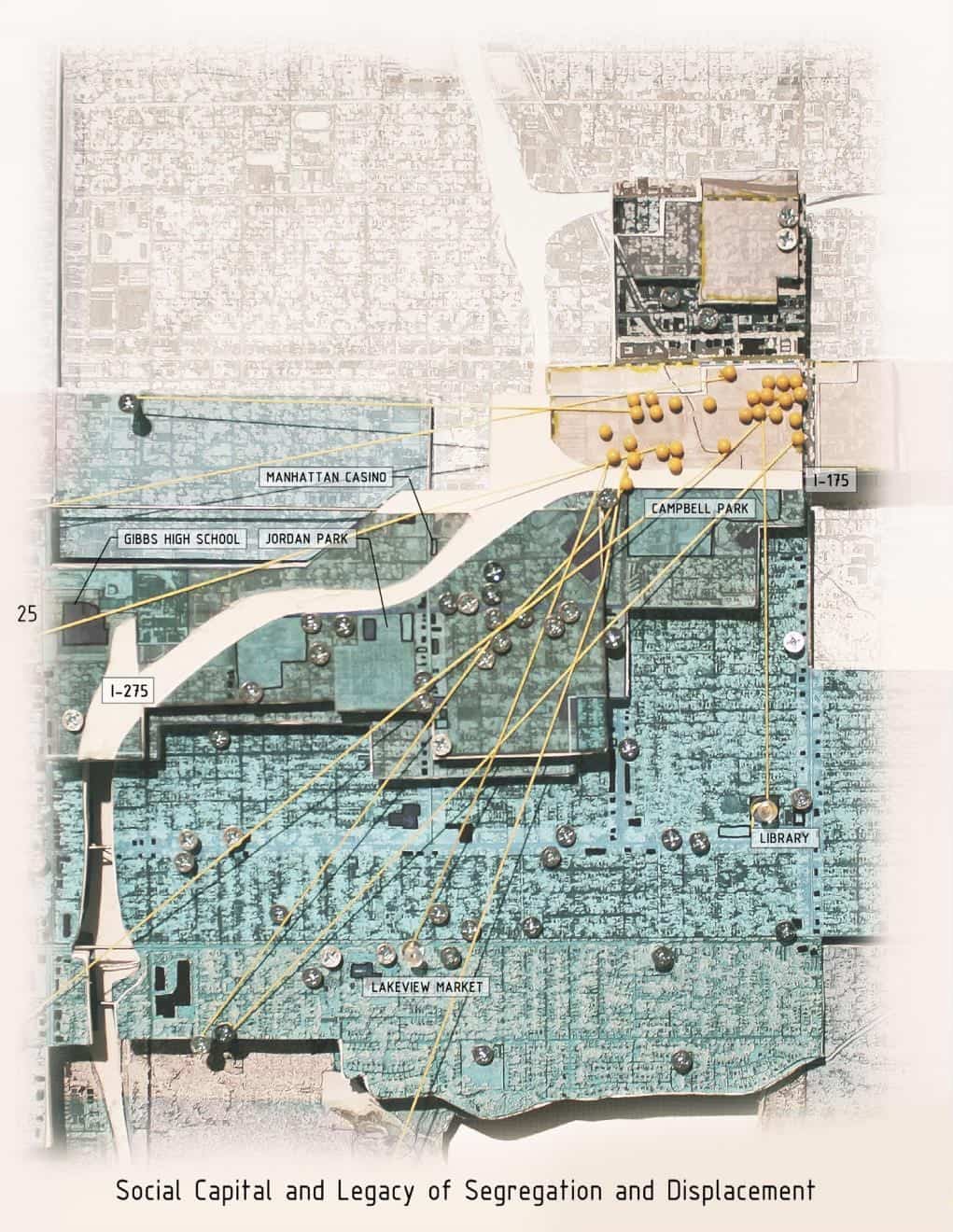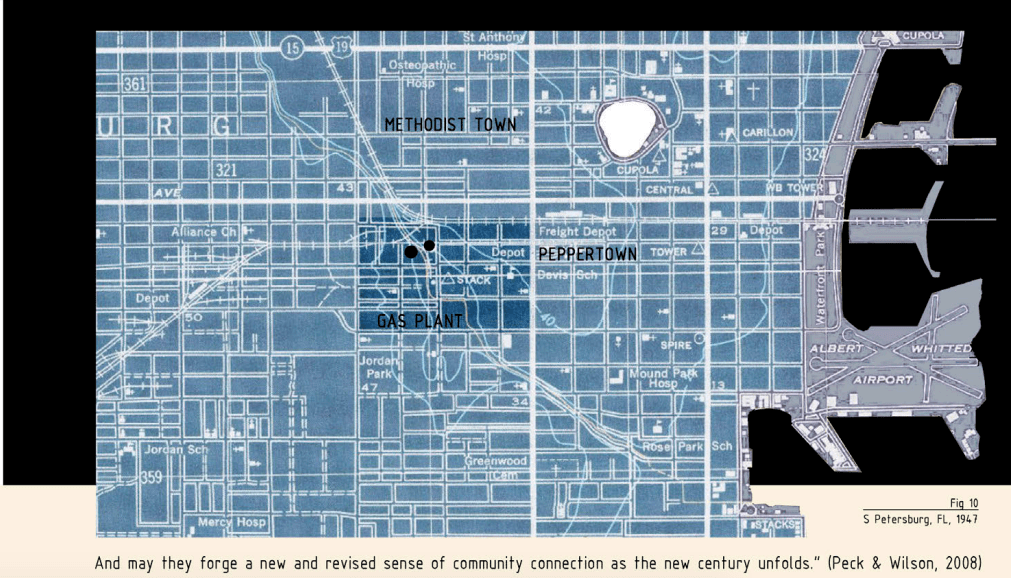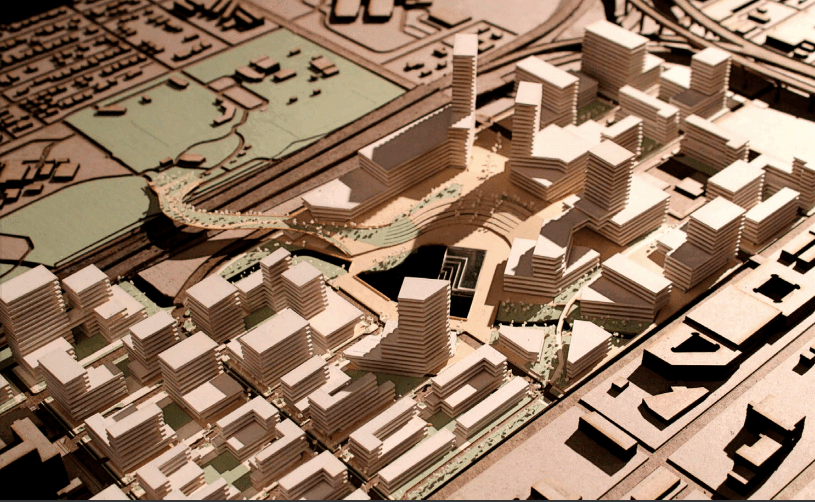Book focused on the history, legacy of Tropicana Field site launches Wednesday

When Sarah Jane Vatelot moved to St. Petersburg in 1997, the Tampa Bay Devil Rays had just signed a 30-year contract with the City of St. Petersburg to play baseball at Tropicana Field. The stadium itself had been completed in 1990, and Interstates 275 and 175, which wrapped around it, had been in place for nearly 17 years.
Vatelot, like most of us who came after, had never thought to question how it got there, or why. “It just always was there,” Vatelot said.
It wasn’t until she was a decade into her career and into her graduate architecture program at the University of South Florida that Vatelot began to investigate further. Less than a decade out from the end of the Rays’ contract, the news had just broken that team owners were looking at possible sites for a new stadium in Tampa. The City of St. Petersburg had invited HKS Architects to reimagine the Tropicana Field site under two scenarios: with or without a baseball stadium.
Vatelot was selected to participate in a simultaneous two-day design charette, hosted by local architecture firm Renker Eich Parks, local developer Feldman Equities and local contracting firm Bandes Construction. As she examined the proposed design by HKS Architects, Vatelot discovered what could have been a typing error, but was representative of so much more: The firm had mislabeled 22nd Street, known locally as The Deuces, the historic African American Main Street. “What it represents is outsiders trying to solve a problem that is local,” said Vatelot. She and her design team began their reimagination efforts with a figure ground, a black and white drawing in which the white is blank space and the black was buildings. When the figure ground was inverted, Vatelot was struck by the void left in the very heart of the city by the 86-acre site and the interstates contributing to it.

Vatelot’s figure ground of the Tropicana Field site.
In that moment, Vatelot’s interest was piqued. She wondered how the site came to be, what was there before the stadium, and what was lost. As she tells it, she fell upon Rosalie Peck and John Wilson’s books, St. Petersburg’s Historic African American Neighborhoods and St. Petersburg’s Historic 22nd St. S for context, and all of the pieces started to fall into place.
“I fell into the information and felt compelled to tell the story the way that I found it,” Vatelot said. “All of the information was already out there, I think it was just kind of scattered. So I just drew lines between dots,” she explained. “That’s really all it is.” The product was a thesis, and ultimately a book, Where Have All The Mangoes Gone? Reactivating The Tropicana Field Site On The Threshold of St. Petersburg’s History, Culture and Memory.
St. Petersburg Press will launch the Mangoes book Wednesday, Jan. 8 at the Florida Holocaust Museum in downtown St. Pete. Vatelot and Gwendolyn Reese of the St. Petersburg African American Heritage Trail will speak at the 6 p.m. event; all proceeds from the book’s sales will go the the African American Heritage Trail.
“What I came to understand is that the real story is not about baseball, it’s about people,” Vatelot wrote in Where Have All The Mangoes Gone?, published in the St. Pete Catalyst in August 2019. “In the Fall of 2018, I embarked upon an eight-month-long study of the site for my master’s thesis at the USF School of Architecture and Community Design, identifying the issues posed by the site’s historical context to propose policy suggestions and design solutions to mend the tear in the physical and social fabric of St Petersburg left by the 86-acre site.
“I was shocked to uncover how far the history of this event could be traced, back to the 1930s, when racial segregation in St. Petersburg became a matter of policy.”
Vatelot spent eight months poring over records, examining historical maps and conducting in-person interviews with business owners and community leaders who resided or did business in the area.

A 1947 map of St. Petersburg, prior to the Interstate, Tropicana Field.
The site has been referred to as the Gas Plant District, because it once housed the city’s gas tanks – two towering cylindrical buildings. Through her research, Vatelot uncovered other, more familiar names for the neighborhoods in the area – its previous title, Cooper’s Quarters, and smaller sub-neighborhoods like Little Egypt, Jamestown and Sugar Hill.
Vatelot began to see the razing of the Gas Plant neighborhood in the context of a mass segregation project that began 50 years earlier, the last in a line of forced relocations from Peppertown, Methodist Town and ultimately the Gas Plant neighborhood. These relocations crippled the African American community’s economic viability, and changed the physical and social fabric of the city forever.

According to Vatelot’s research, after declaring the Gas Plant a “redevelopment area” in 1978, the City used $11.3 million in federal community development grants to acquire the land through eminent domain and demolish the neighborhood. All told, the City of St. Petersburg gathered more than 86 acres of previously occupied space, promising in writing that the neighborhood would be rebuilt with affordable housing and a modern industrial park, bringing with it 600 new jobs and $5.6 million in combined salaries by 1990.
In 1980, construction of Interstate 175 was completed, situated on the razed Sugar Hill neighborhood, which was home to many firsts for St. Petersburg’s African American community: the first school, Davis Academy, the first medical treatment facility and the first library. It was also home to the Harlem Theater, 13 churches, cemeteries, many local businesses and hundreds of residents. Instead of affordable housing and industry, eight years later, the city council later voted 6-2 to build the Suncoast Dome, which would later become Tropicana Field.
For her thesis, Vatelot interviewed Daisy Swinton, who now runs Lakeview Market on 22nd Ave S., and whose business was relocated from the Gas Plant District. She explained that the “greatest loss” of the razing of the Gas Plant District was economic. Of the many businesses relocated from the Gas Plant, Swinton’s was the only one that Vatelot was able to find still in operation.
“It was another broken promise and the realization of a 50-year project,” wrote Vatelot.
“The research I did for the Tropicana Field site applies to Commerce Park and 22nd St. S as well,” Vatelot told the Catalyst. “If you look at the Manhattan Casino, it’s the one surviving part of the community that existed there, it’s just completely severed off from the rest of the neighborhood. You have to believe that there’s some intention there as well, [the highway] could have easily gone over it to keep it with the rest of the community. There are too many coincidences, I think, in the way that the lines of the highway were drawn … Most things are intentional. When you put all of these elements together it tells a story.”
Vatelot’s proposed design for the re-imagined site is called Sugar Hill, in homage to the neighborhood. She credits Peck for the basis of her thesis, that what was lost when Tropicana Field and the interstates surrounding it were built was connectivity, both pedestrian and vehicular. She believes that a re-imagined site should restore connectivity in a radical way.
Vatelot didn’t believe that the HKS Architects plan was a bad one; the basic solutions were certainly appropriate for that place. A mixed-use neighborhood was needed, commercial and residential, office and retail, all of it was necessary, but something was missing.
“We do need those things,” she said. “But they need to be done in a way that connects people rather than further displaces them, and I think that’s the issue, ultimately. We have to think about it in terms of inclusive design, intentionally inclusive design.” Vatelot and her team designed an urban plaza, called Urban Beach, as a bastion against the forces of gentrification and displacement.

Vatelot’s Urban Beach plaza.
The plan is meant to bring the intensity of downtown to the center of the city, to site that at present lies empty and inactive aside from the stadium itself. “A park is about the nature that is around it, it celebrates nature,” said Vatelot, “but an urban plaza celebrates the people in that place. People come together, social cohesion occurs, it’s a space of belonging. Anyone can go there and be a part of it.”
Straub Park is utilized as a sort of civic center of the city, home to firework displays and festivals. But Vatelot believes that an urban plaza design at the Tropicana Field site could become a connecting point, rich with access points from all areas of the community, if the city’s grid system is reconnected through the site. Vatelot sees the site as a complement to Straub Park, rather than a replacement – the two serving as bookends to the city’s downtown.
Vatelot was particularly concerned with including bridging elements in her design, re-connecting Campbell Park, south of I-175, with the Tropicana Field site. That bridge is reflected in her model.
“It has to be a monumental gesture, it can’t be shy,” Vatelot explained. “It needs to be a gathering space.”
Vatelot’s model includes I-175, and the plaza is designed to bridge over and connect the community despite it. But, ideally, she said, the interstate should be razed entirely, an idea that has been proposed by HKS Architects as well. The Florida Department of Transportation, however, has no precedent for making such moves.
To learn more about Sarah Jane Vatelot’s work, join her at the St. Petersburg Press and St. Petersburg Downtown Partnership event Jan. 8. Details can be found here.



Maria Scruggs
January 10, 2020at11:35 pm
I really appreciate anybody that sees value in our story…I am just baffled that story telling is a part of the African tradition, but we can’t seem to hear our story from those of us that lived it.
S. Rose Smith-Hayes
January 8, 2020at12:47 pm
This article was written with heart. This writer gets it, exactly what the community lost when the ‘Tropicana field’ promises were not kept. A Community was lied to and forgotten. Over 100 Black owned business died and some people died due to broken hearts when the promises were not kept.